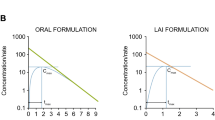Abstract
In our hospital pharmacy an injectable solution of haloperidol decanoate 141 mg/ml (equivalent to haloperidol 100 mg/ml) in sesame oil was prepared. The aim of this study was to prove bioequivalence of this formulation with the reference product, Haldol Decanoas®. 15 schizophrenic patients, already stabilized with Haldol Decanoas®, were enrolled. Intramuscular injections were given every three weeks in the following doses: 100 mg (1 ×), 200 mg (7 ×) and 300 mg (7 ×). In this open, randomized, cross-over study all patients received four injections of the reference product, and four injections of the test product. Only after the fourth injection of each product (when steady-state levels were reached) a concentration-time profile of haloperidol was established during the dose interval of 21 days. The pharmacokinetic parameters AUC0–21 and Cmax were statistically evaluated. Based on these parameters the conclusion was drawn that both products were bioequivalent. The preparation of this injectable haloperidol decanoate solution in our hospital pharmacy amounts to an annual saving of approximately $39,000.
Similar content being viewed by others
References
Beresford R, Ward A. Haloperidol decanoate; a preliminary review of its pharmacodynamic and pharmacokinetic properties and therapeutic use in psychosis. Drugs 1987;33: 31–49.
Pakes GE. Haloperidol decanoate in perspective. In: Johnson DAW, editor. Haloperidol decanoate and the treatment of chronic schizophrenia. New York: Adis Press, 1982:108–11.
Reyntjes AJM, Heykants JJP, Woestenborghs RJH, Gelders YG, Aerts TJL. Pharmacokinetics of haloperidol decanoate: a 2-year follow-up. Int Pharmacopsychiat 1982, 17:238–46.
Deberdt R, Elens P, Berghmans W, Heykants J, Woestenborghs R, Driesens F, et al. Intramuscular haloperidol decanoate for neuroleptic maintenance therapy. Efficacy, dosage schedule and plasma levels. An open multicenter study. Acta Psychiat Scand 1980;62:356–63.
Suy E, Woestenborghs R, Heykants J. Bioavailability and clinical effect of two different concentrations of haloperidol decanoate. Curr Ther Res 1982;31:982–91.
Nayak RK, Nair NPV, Doose DR, McCarthy LR, Desiraju RK. Pharmacokinetics of haloperidol and haloperidol decanoate in schizophrenic patients. Clin Pharmacol Ther 1985;37:217.
Nayak RK, Doose DR, Nair NPV. The bioavailability and pharmacokinetics of oral and depot intramuscular haloperidol in schizophrenic patients. J Clin Pharmacol 1987;27:144–50.
De Cuyper H, Bollen J, Van Praag HM, Verstraeten D. Pharmacokinetics and therapeutic efficacy of haloperidol decanoate after loading dose administration. Br J Psychiatry 1986;148:560–6.
American Psychiatric Association. Diagnostic and statistical manual of mental disorders. 3rd ed., revised. Washington: American Psychiatric Press, 1987.
Bouma P, Uges DRA. De bepaling van enige xenobiotica in lichaamsvloeistoffen. Praktische analysevoorschriften IV. Haloperidol [Methods for the analysis of some xenobiotics in body fluids. Haloperidol]. Ziekenhuisfarmacie 1987;3(4): 147.
Westlake WJ. Use of confidence intervals in analysis of comparative bioavailability trials. J Pharm Sci 1972;61:1340–1.
Westlake WJ. Statistical aspects of comparative bioavailability trials. Biometrics 1979;35:273–80.
Rodda BE, Davis RL. Determining the probability of an important difference in bioavailability. Clin Pharmacol Ther 1980;28:247–52.
Fluehler H, Hirtz J, Moser HA. An aid to decision-making in bioequivalence assessment. J Pharmacokinet Biopharm 1981;9:235–43.
Fluehler H, Grieve AP, Mandallaz D, Mau J, Moser HA. Bayesian approach to bioequivalence assessment: an example. J Pharm Sci 1983;72:1178–81.
Hauck WW, Anderson S. A new statistical procedure for testing equivalence in two groups comparative bioavailability trials. J Pharmacokinet Biopharm 1984;12:83–91.
Rocke DM. On testing for bioequivalence. Biometrics 1984;40:225–30.
Baldessarini RJ, Frankenburg FR. Clozapine. A novel antipsychotic agent. N Engl J Med 1991;324:746–54.
Zuidema J, Pieters FAJM, Duchateau GSMJE. Release and absorption rate aspects of intramuscularly injected pharmaceuticals. Int J Pharm 1988;47:1–12.
Schuirmann DJ. A comparison of the two one-sided tests procedure and the power approach for assessing the equivalence of average bioavailability. J Pharmacokinet Biopharm 1987;15:657–80.
Author information
Authors and Affiliations
Rights and permissions
About this article
Cite this article
van Weringh, G., Komen, B.J., Thieme, R.E. et al. Comparative bioavailability study of two haloperidol decanoate containing products. Pharm World Sci 16, 343–347 (1994). https://doi.org/10.1007/BF02178564
Accepted:
Issue Date:
DOI: https://doi.org/10.1007/BF02178564




